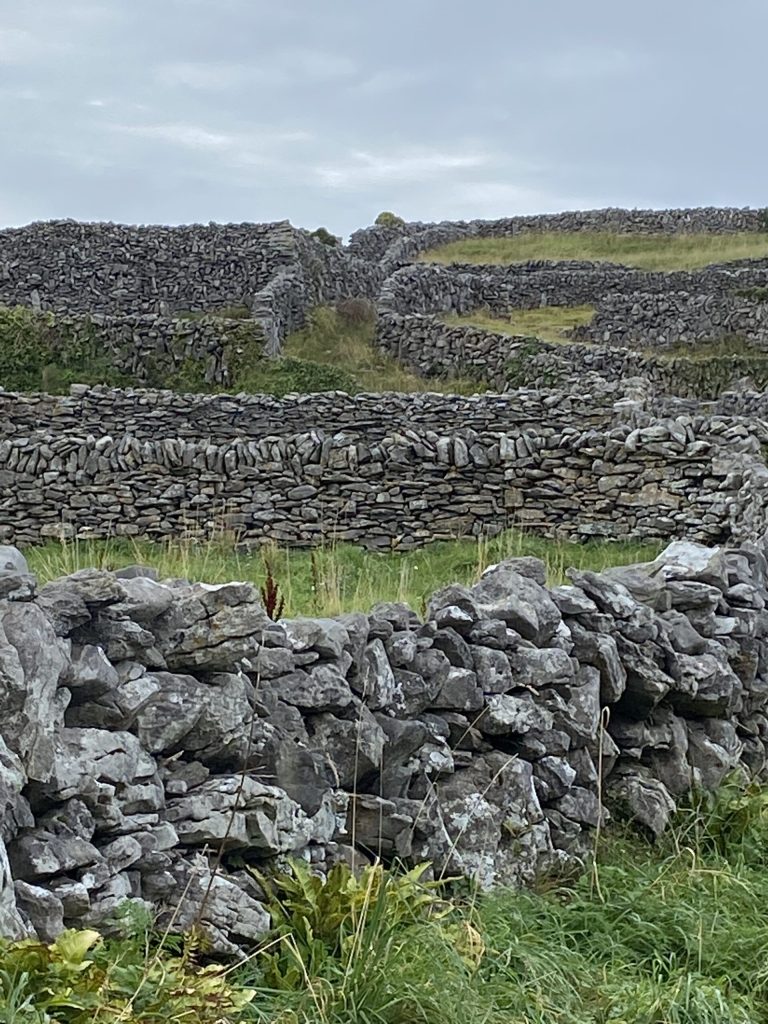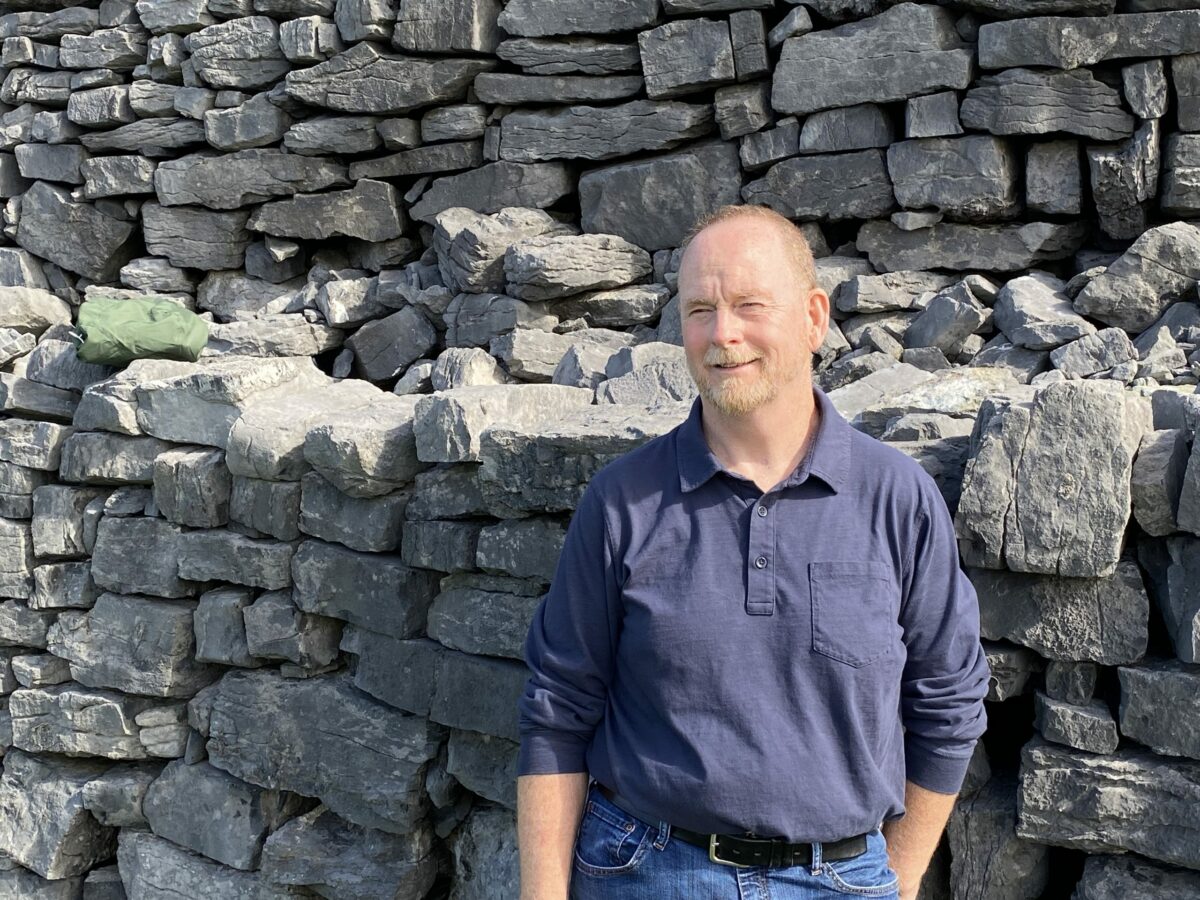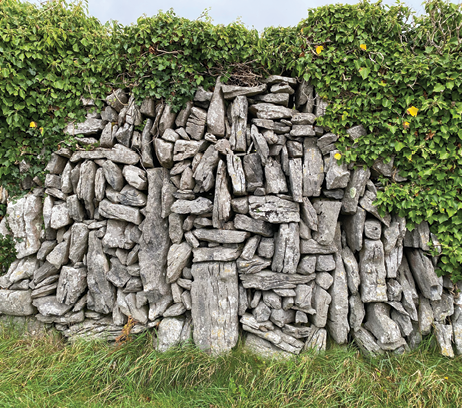
STONE MAD: The Making of a Wall
By John Digney

One might wonder why a person would travel 4,000 miles to a distant island just to labor over a pile of stones and spend all his retirement days wearing steel toed boots and work gloves? Well, it is certainly not for everyone, but when you have admitted being stone mad, it is part of the program.
I had gained the opportunity to connect with friends after three years of COVID and learn about an ancient craft that is alive and well on a remote island off the coast of Galway. I set my sites on the third week of September to travel to the smallest of the Aran islands, Inisheer. There, I immersed myself in the island life while preparing to build a Feiden Wall as part of the three-day stone festival Feil na gCloch.
To work side by side with people who are passionate about stone, will certainly bring me back and I hope sparks interest in others to get involved. They are the stewards of the ancient craft and true artists whose palette is found only from the earth.

Innisheer
When arriving to the island from the ferry, it becomes immediately apparent that Inisheer is frozen in another place in time. From horse drawn carriages awaiting one’s arrival, the limestone outcroppings sculpting the shoreline, and the welcoming smiles from the locals, it makes stepping off to this adventure what many would call a soft landing.
The first few days were an opportunity to experience local life, explore roads lined with stones as high as one could reach, and take note of the years that have passed since they were first set. It was truly an amazing experience to witness all the variety in the way the stones were stacked. Even so, these walls have continued to stand strong for years against the wind and rain that is ever present in the north Atlantic.
I noticed many stone wallers beginning to arrive on the island, along with a very large collection of limestone rocks being delivered, adjacent to the proposed wall site. The build would include wallers from across the globe; Canada and the US and places as far as Austria, Australia and Korea, as well as many members of the DSWAI from Ireland.
I will explain just how a wall is built and the essence of the experience as it unfolded over three days of the festival. Fortunately, in anticipation of the wall being built, our hosts did all the necessary site work and preparation prior to our arrival. The foundation work and vertical stones that were set established the direction of the wall and the course level we were to follow once we were introduced to the basics.
With some very specific instruction and a better understanding of the Feiden Wall layout, we selected and placed stones as we worked. A Feiden Wall, a common wall on the Aran Islands, consists of uniquely specific components. The “mother stones” are placed vertically, as pillars, about 2-3 meters apart, that contain or tend to the “children stones” which are placed in between.
The wall we were building was a double-faced wall, meaning it has an even stone face on both sides of the wall with the mother stones keeping it in line. A critical part of dry-stone walling is the smaller stones that are not seen once the wall is complete. These are referred to as “pinning stones” and “hearting stones” which are placed in the center of the wall with highly intentional placement and purpose.
Pinning Stones Hearting Stones
These pinning stones are small slices of stone that are used to level the face stones and help to lock in all the stones with vertical pressure. The hearting stones, which are larger in size than the pinning stones, are used to fill any horizontal voids in the center of the wall.
One must pay close attention that the level is consistent for each additional stone course. With the vertical pressure and gravity to settle the wall, these two integral parts assist in strengthening the wall along the entire run. Once all the children stones are placed, the entire wall is topped off with “father stones” that span the entire length of the wall.
One prominent aspect of walling that I had not anticipated, was the finesse and rhythmic choreography that came about naturally throughout the day. The nonstop clicking of the sledgehammer on the large stones, combined with the delicate chiseling and tapping as we shaped and fit each individual stone provided a deep sense of relaxation.
This constant chatter and clacking of the mallets were almost musical when fully taken in. Although it is most certainly hard work, the labor is lessoned by the camaraderie, community engagement, and the friendships forged through the process. The connection that is made on the wall is not left there but rather is carried with you.
I would like to thank the members of the Dry Stone Wall Association of Ireland for spending time to teach and instruct us on Inisheer, and for providing us with the knowledge and insight that we can share with so many others. We will continue to work with DSWAI to bring you content, stories and information published here in iIrish as well as on the internet at www.iIrish.us
*John Digney is an Artist /Designer who received his BFA in Industrial Design from the Cleveland Institute of Art. He was raised in the Cleveland neighborhood of Westpark near Kamm’s Corner, and he and his wife Kathleen, now reside in Greenville, SC. John can be reached at [email protected]

Monthly newsmagazine serving people of Irish descent from Cleveland to Clearwater. We cover the movers, shakers & music makers each and every month.
Since our 2006 inception, iIrish has donated more than $376,000 to local and national charities.
GET UPDATES ON THE SERIOUS & THE SHENANIGANS!